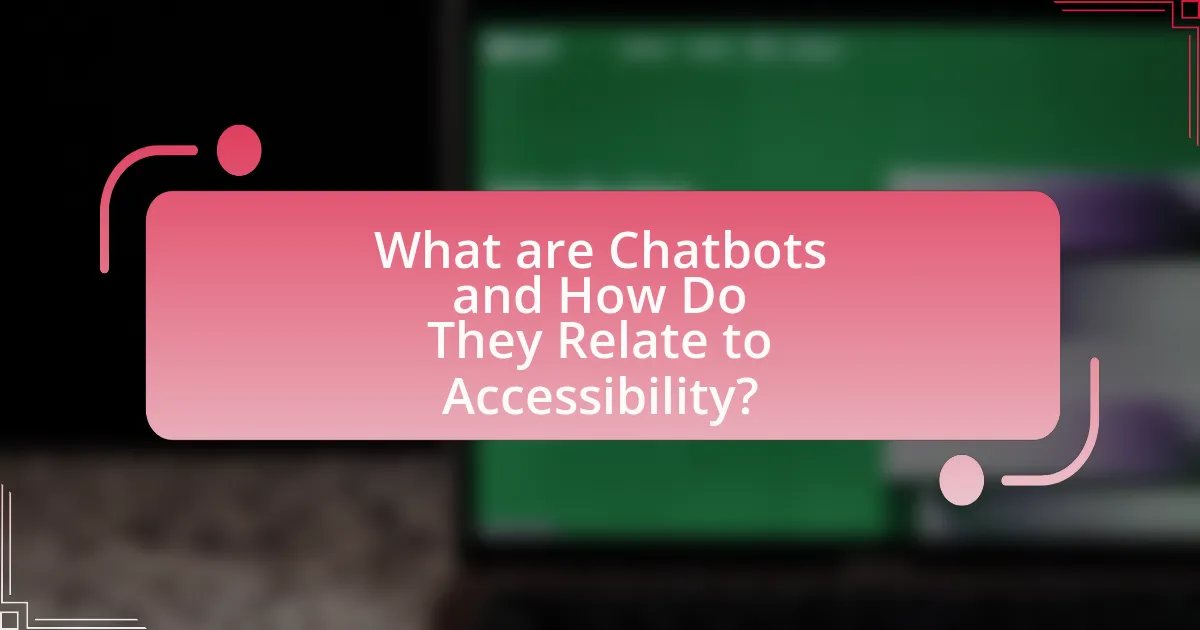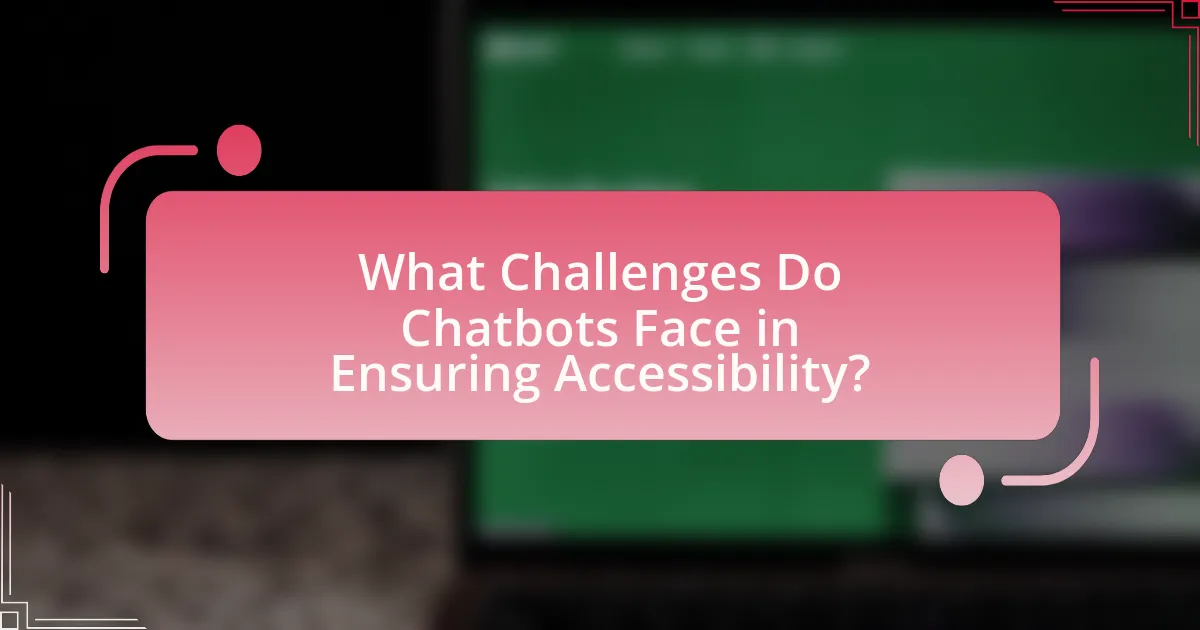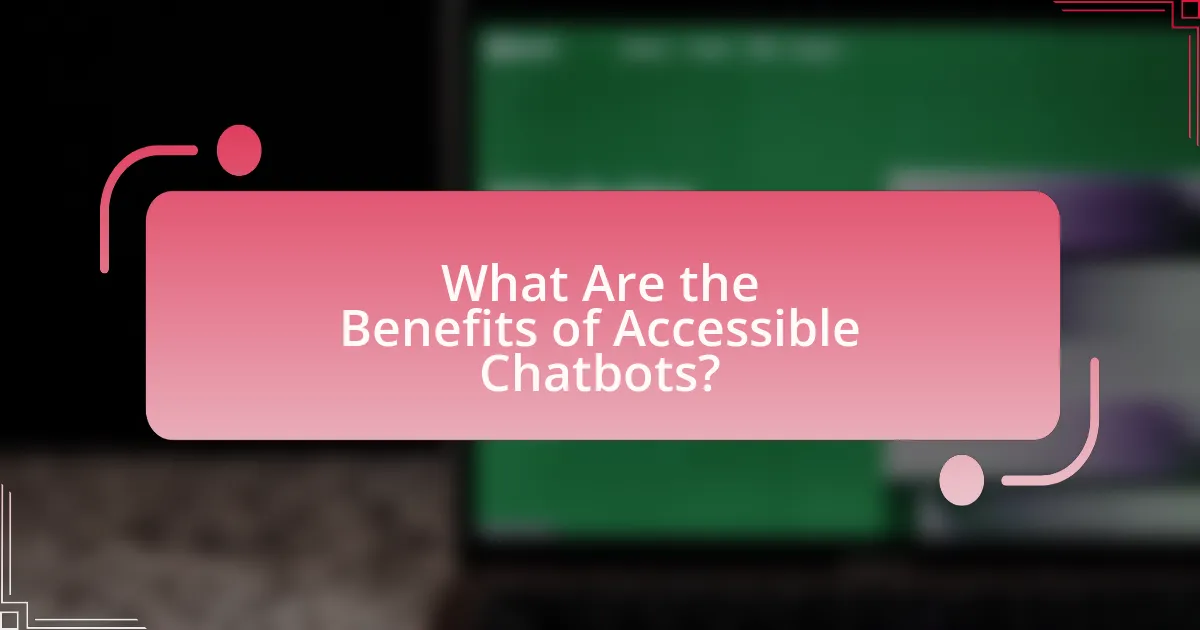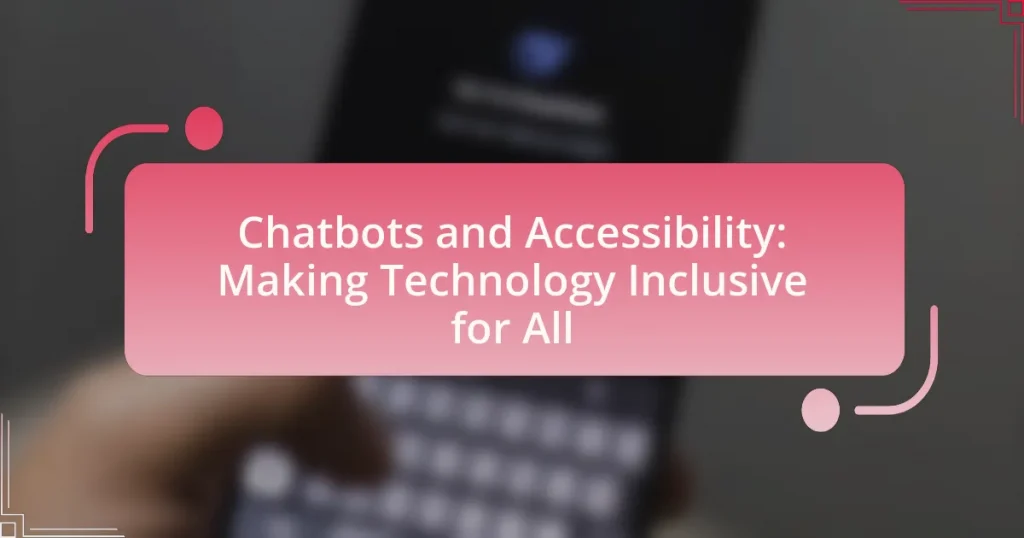Chatbots are automated conversational agents that facilitate communication through text or voice, playing a crucial role in enhancing accessibility for individuals with disabilities. This article explores how chatbots improve user experience by providing inclusive communication options, such as speech recognition and text-to-speech capabilities, which cater to diverse needs. It also examines the technologies that enable chatbots to assist users with disabilities, the legal requirements for accessibility, and the challenges faced in ensuring effective chatbot accessibility. Additionally, the article highlights the benefits of accessible chatbots for user engagement, customer satisfaction, and business advantages, emphasizing the importance of inclusive design in technology.

What are Chatbots and How Do They Relate to Accessibility?
Chatbots are automated conversational agents that interact with users through text or voice, providing information and assistance. They relate to accessibility by offering inclusive communication options for individuals with disabilities, such as those with visual impairments who can use voice commands or screen readers to interact with chatbots. Research indicates that chatbots can enhance user experience by providing immediate responses and support, thereby reducing barriers to information access for people with disabilities. For example, a study by the World Health Organization highlights that digital tools like chatbots can improve health service accessibility for individuals with mobility or sensory impairments.
How do chatbots function in the context of accessibility?
Chatbots function in the context of accessibility by providing users with immediate, text-based communication that can be tailored to meet diverse needs. They enhance accessibility by offering features such as speech recognition, text-to-speech capabilities, and support for multiple languages, which help individuals with disabilities interact with technology more effectively. For instance, a study by the World Health Organization indicates that over 1 billion people globally experience some form of disability, highlighting the importance of accessible technology solutions like chatbots. These tools can also integrate with assistive technologies, ensuring that users with visual impairments or cognitive disabilities can access information and services seamlessly.
What technologies enable chatbots to assist users with disabilities?
Chatbots utilize several technologies to assist users with disabilities, including natural language processing (NLP), speech recognition, text-to-speech (TTS), and machine learning. NLP enables chatbots to understand and respond to user queries in a conversational manner, making interactions more accessible for individuals with cognitive disabilities. Speech recognition allows users with mobility impairments to interact with chatbots using voice commands, while TTS technology provides auditory feedback, aiding users with visual impairments. Machine learning enhances the chatbot’s ability to learn from user interactions, improving its responses over time and making it more effective for users with diverse needs. These technologies collectively contribute to creating an inclusive environment for users with disabilities.
How do chatbots adapt to different accessibility needs?
Chatbots adapt to different accessibility needs by incorporating features such as voice recognition, text-to-speech capabilities, and customizable interfaces. These adaptations ensure that users with varying abilities can effectively interact with the chatbot. For instance, voice recognition allows individuals with visual impairments to communicate without needing to read or type, while text-to-speech functionality enables users to hear responses, enhancing usability for those with reading difficulties. Additionally, chatbots can offer adjustable text sizes and color contrasts to accommodate users with visual impairments, thereby promoting inclusivity. Research indicates that implementing these features significantly improves user satisfaction and engagement, demonstrating the effectiveness of adaptive technologies in enhancing accessibility.
Why is accessibility important in technology?
Accessibility is important in technology because it ensures that all individuals, regardless of their abilities or disabilities, can effectively use and benefit from technological products and services. By incorporating accessibility features, technology becomes inclusive, allowing people with visual, auditory, motor, or cognitive impairments to engage with digital content. For instance, the World Health Organization estimates that over 1 billion people globally experience some form of disability, highlighting the necessity for accessible technology to accommodate this significant portion of the population. Furthermore, accessible technology can enhance user experience for everyone, as features like voice recognition and text-to-speech can improve usability across diverse user groups.
What are the legal requirements for accessibility in technology?
The legal requirements for accessibility in technology primarily stem from the Americans with Disabilities Act (ADA), which mandates that public accommodations, including websites and applications, must be accessible to individuals with disabilities. This requirement is reinforced by Section 508 of the Rehabilitation Act, which obligates federal agencies to ensure their electronic and information technology is accessible. Additionally, the Web Content Accessibility Guidelines (WCAG) provide a framework for meeting these legal standards by outlining specific criteria for web accessibility. Compliance with these guidelines is often used as a benchmark for legal adherence, as courts have increasingly referenced WCAG in rulings related to accessibility cases.
How does accessibility impact user experience and engagement?
Accessibility significantly enhances user experience and engagement by ensuring that all users, regardless of their abilities, can effectively interact with technology. When digital platforms, including chatbots, are designed with accessibility in mind, they accommodate diverse needs, such as visual impairments, hearing loss, and cognitive disabilities. Research indicates that accessible design can lead to increased user satisfaction and retention; for instance, a study by the Web Accessibility Initiative found that 71% of users with disabilities will leave a website that is not accessible. This demonstrates that prioritizing accessibility not only fosters inclusivity but also drives higher engagement and loyalty among users.

What Challenges Do Chatbots Face in Ensuring Accessibility?
Chatbots face several challenges in ensuring accessibility, primarily related to language understanding, user interface design, and integration with assistive technologies. Language understanding issues arise when chatbots struggle to interpret diverse dialects, accents, or colloquialisms, which can alienate users with varying linguistic backgrounds. User interface design challenges include creating visually accessible layouts that accommodate users with visual impairments, as well as ensuring that navigation is intuitive for individuals with cognitive disabilities. Additionally, the integration of chatbots with assistive technologies, such as screen readers or voice recognition software, often presents compatibility issues, limiting the effectiveness of these tools for users with disabilities. These challenges highlight the need for ongoing improvements in chatbot technology to enhance inclusivity and accessibility for all users.
What are common barriers to effective chatbot accessibility?
Common barriers to effective chatbot accessibility include lack of support for diverse languages, insufficient compatibility with assistive technologies, and inadequate user interface design. These barriers hinder users with different linguistic backgrounds, disabilities, or varying levels of digital literacy from effectively interacting with chatbots. For instance, a study by the World Health Organization indicates that approximately 15% of the global population experiences some form of disability, highlighting the need for chatbots to be designed with accessibility in mind to ensure inclusivity.
How do language and communication styles affect chatbot accessibility?
Language and communication styles significantly affect chatbot accessibility by determining how effectively users can interact with the chatbot. For instance, chatbots that utilize simple, clear language and accommodate various communication styles, such as formal or informal tones, enhance user understanding and engagement. Research indicates that 70% of users prefer chatbots that can adapt to their language preferences, which directly impacts user satisfaction and accessibility. Additionally, incorporating features like multilingual support and the ability to recognize different dialects or colloquialisms can further improve accessibility for diverse user groups, ensuring that more individuals can effectively utilize chatbot technology.
What role does user interface design play in chatbot accessibility?
User interface design is crucial for chatbot accessibility as it directly influences how users interact with the chatbot. A well-designed interface ensures that users, including those with disabilities, can easily navigate, understand, and utilize the chatbot’s features. For instance, incorporating clear visual elements, intuitive layouts, and support for screen readers enhances usability for individuals with visual impairments. Research indicates that 15% of the global population experiences some form of disability, highlighting the necessity for inclusive design practices. By prioritizing user interface design, developers can create chatbots that are accessible to a broader audience, thereby promoting inclusivity in technology.
How can developers overcome these challenges?
Developers can overcome challenges in chatbot accessibility by implementing inclusive design principles and utilizing assistive technologies. By adhering to guidelines such as the Web Content Accessibility Guidelines (WCAG), developers ensure that chatbots are usable for individuals with disabilities. For instance, incorporating text-to-speech functionality allows visually impaired users to interact with chatbots effectively. Additionally, conducting user testing with diverse groups, including those with disabilities, provides valuable feedback that can inform improvements. Research indicates that accessible design not only benefits users with disabilities but also enhances overall user experience, as evidenced by a study from the Nielsen Norman Group, which found that inclusive design practices lead to higher satisfaction rates among all users.
What best practices should developers follow for accessible chatbot design?
Developers should follow several best practices for accessible chatbot design, including ensuring compatibility with screen readers, providing text alternatives for non-text content, and using clear and simple language. Compatibility with screen readers allows visually impaired users to interact with the chatbot effectively, as studies show that over 285 million people worldwide are visually impaired. Text alternatives for images and multimedia enhance understanding for users with disabilities, aligning with the Web Content Accessibility Guidelines (WCAG) that emphasize the importance of alternative text. Additionally, using clear and simple language improves comprehension for users with cognitive disabilities, as research indicates that plain language can significantly enhance user experience and accessibility.
How can user feedback improve chatbot accessibility?
User feedback can significantly improve chatbot accessibility by identifying specific barriers that users encounter while interacting with the chatbot. When users provide insights about their experiences, developers can pinpoint issues such as unclear language, navigation difficulties, or inadequate support for assistive technologies. For instance, a study by the World Health Organization indicates that 15% of the global population experiences some form of disability, highlighting the necessity for chatbots to be designed with inclusivity in mind. By analyzing user feedback, developers can implement changes that enhance usability, such as simplifying language, improving voice recognition, or ensuring compatibility with screen readers, ultimately leading to a more accessible and user-friendly chatbot experience.

What Are the Benefits of Accessible Chatbots?
Accessible chatbots enhance user experience by providing inclusive communication options for individuals with disabilities. These chatbots can support various accessibility features, such as text-to-speech, speech recognition, and compatibility with screen readers, ensuring that users with visual or auditory impairments can interact effectively. According to a study by the World Health Organization, approximately 15% of the global population experiences some form of disability, highlighting the necessity for technology that accommodates diverse needs. By implementing accessible chatbots, organizations can improve customer satisfaction, increase engagement, and expand their reach to a broader audience, ultimately fostering a more inclusive digital environment.
How do accessible chatbots enhance user engagement?
Accessible chatbots enhance user engagement by providing inclusive communication options that cater to diverse user needs. These chatbots utilize features such as voice recognition, text-to-speech, and multilingual support, which allow users with varying abilities and preferences to interact seamlessly. Research indicates that 70% of users prefer chatbots that can accommodate their specific accessibility requirements, leading to increased satisfaction and interaction rates. By ensuring that all users can easily access information and services, accessible chatbots foster a more engaging and user-friendly experience.
What specific user groups benefit from accessible chatbots?
Accessible chatbots benefit several specific user groups, including individuals with disabilities, the elderly, and non-native language speakers. Individuals with disabilities, such as visual impairments or cognitive challenges, find accessible chatbots essential for navigating digital environments independently. The elderly often require simplified interfaces and voice interaction, which accessible chatbots provide, enhancing their user experience. Non-native language speakers benefit from chatbots that offer multilingual support and simplified language options, making information more accessible. These user groups demonstrate the importance of inclusivity in technology, as highlighted by studies showing that accessible design improves user satisfaction and engagement across diverse populations.
How do accessible chatbots contribute to inclusivity in technology?
Accessible chatbots enhance inclusivity in technology by providing equal access to information and services for individuals with diverse needs, including those with disabilities. These chatbots are designed with features such as voice recognition, text-to-speech capabilities, and support for multiple languages, which cater to users who may have visual impairments, hearing difficulties, or language barriers. For instance, a study by the World Health Organization indicates that over 1 billion people globally experience some form of disability, highlighting the necessity for technology that accommodates these users. By integrating accessibility features, chatbots ensure that all individuals can engage with digital platforms, thereby fostering a more inclusive technological environment.
What are the potential business advantages of implementing accessible chatbots?
Implementing accessible chatbots offers significant business advantages, including enhanced customer engagement, increased market reach, and improved brand reputation. Accessible chatbots cater to a diverse audience, including individuals with disabilities, which can lead to a broader customer base. According to the World Health Organization, over 1 billion people globally experience some form of disability, highlighting the importance of inclusivity in technology. Furthermore, businesses that prioritize accessibility often see higher customer satisfaction rates, as these chatbots provide seamless interactions for all users. This commitment to inclusivity can enhance brand loyalty and attract new customers, ultimately driving revenue growth.
How can accessible chatbots improve customer satisfaction and loyalty?
Accessible chatbots can significantly improve customer satisfaction and loyalty by providing inclusive and efficient support to all users, including those with disabilities. These chatbots enhance user experience through features like voice recognition, text-to-speech, and easy navigation, which cater to diverse needs. For instance, a study by the Pew Research Center found that 56% of adults with disabilities reported difficulties in accessing online services, indicating a strong demand for accessible solutions. By addressing these challenges, accessible chatbots foster a sense of belonging and trust among customers, leading to increased loyalty and repeat engagement.
What cost savings can businesses achieve through accessible chatbot solutions?
Businesses can achieve significant cost savings through accessible chatbot solutions by reducing operational expenses and improving efficiency. Chatbots can handle a high volume of customer inquiries simultaneously, which decreases the need for extensive customer service staff. For instance, a study by Juniper Research estimates that chatbots will help businesses save over $8 billion annually by 2024 through reduced labor costs and increased productivity. Additionally, accessible chatbots can enhance customer satisfaction and retention, leading to increased sales and reduced churn rates, further contributing to overall cost savings.
What are some practical tips for implementing accessible chatbots?
To implement accessible chatbots, ensure they support screen readers and provide text alternatives for visual content. This includes using semantic HTML and ARIA (Accessible Rich Internet Applications) attributes to enhance navigation for users with disabilities. Additionally, design chatbots with clear, concise language and avoid jargon to improve comprehension. Testing with real users, including those with disabilities, is crucial to identify and rectify accessibility issues. Research indicates that 15% of the global population experiences some form of disability, highlighting the importance of inclusive design in technology.










